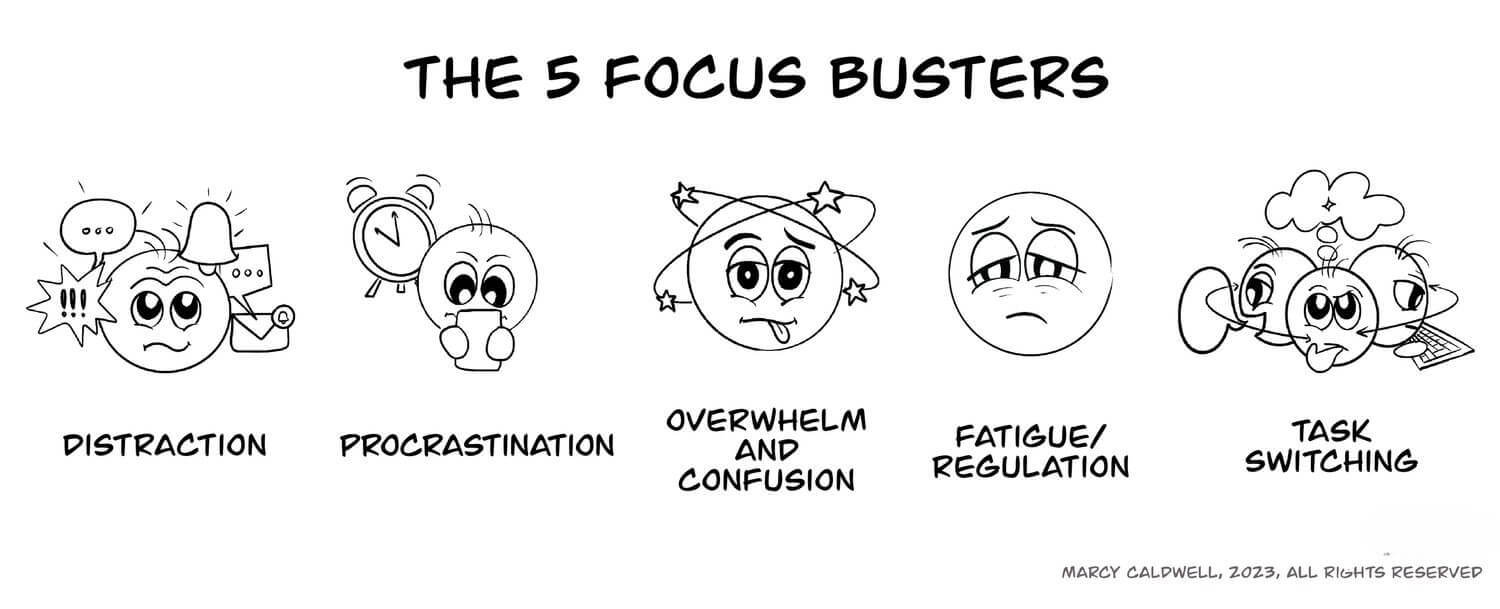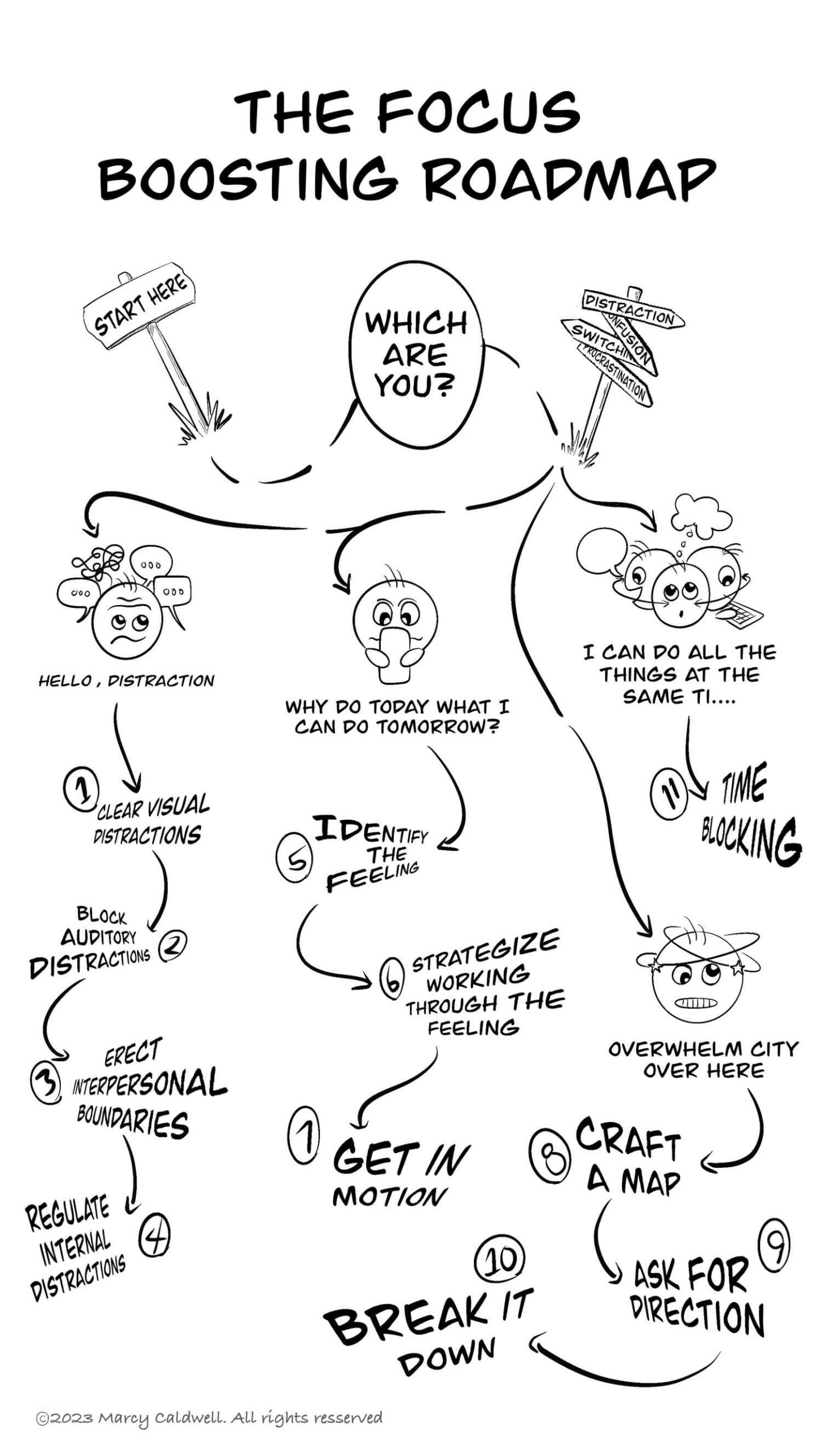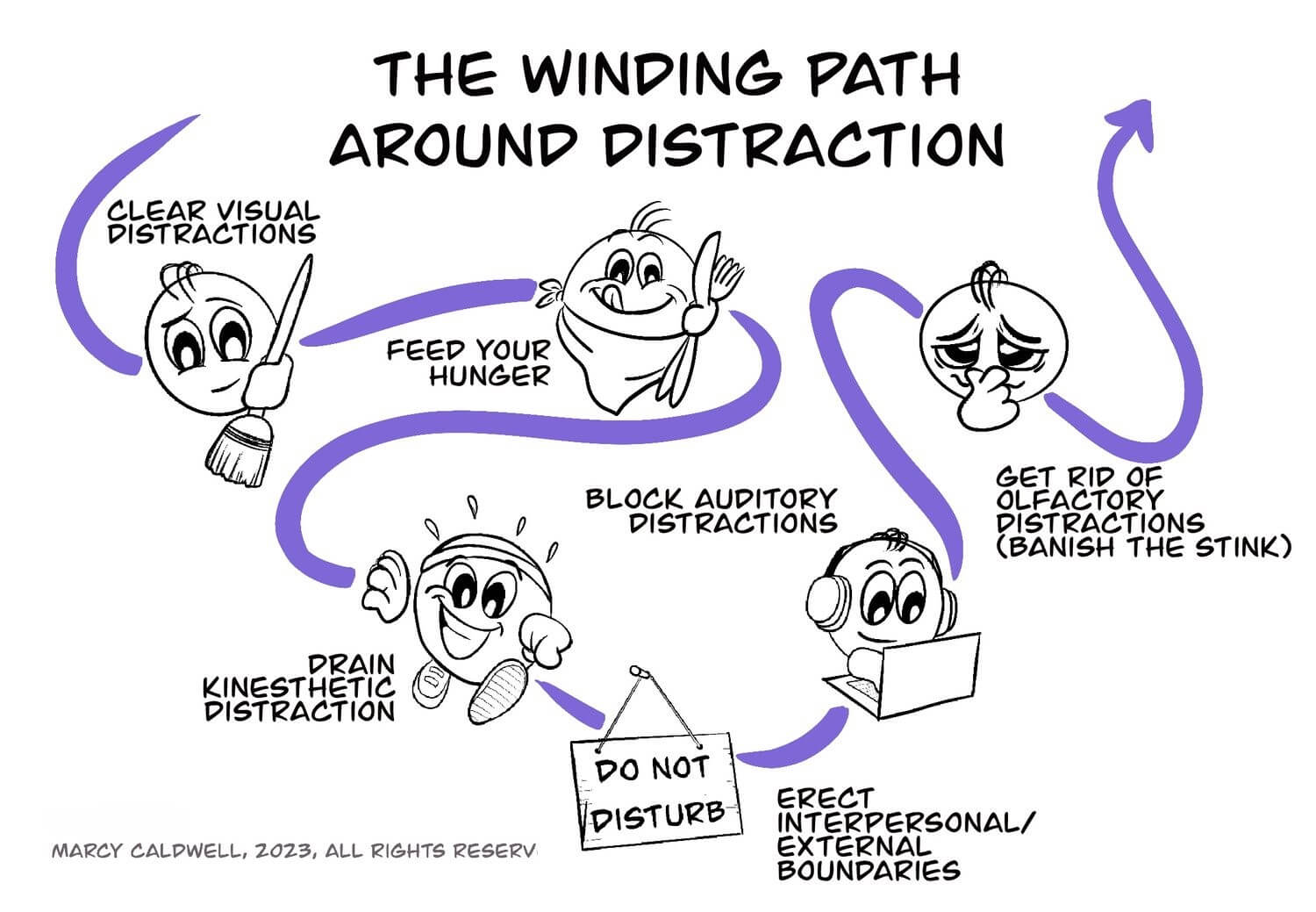The office muzak is pumping, your cubicle mates are chatting, your phone is buzzing, and that overwhelming, utterly confusing report your boss assigned you is the last thing you want to tackle.
And so, the day unfolds into an endless merry-go-round of bathroom breaks, coffee refills, chats with your neighbor, and email checking. And as you pack up your bag for the day, you have that sinking knowing that Nothing. Got. Done.
Why is it so darn hard to get focused?
What Gets in the Way of Focus When You’re Living with ADHD
It may seem like it’s just the nature of an ADHD brain to lack focus. There are times when all the stars are aligned when not only are we on task, but we’re hyper-focused. So, lack of focus isn’t necessarily the default setting. It’s one of our on/off switches, and there are 4 factors that are custom-made to switch it into OFF mode pretty darn quickly.
If you’ve ever searched for how to focus with ADHD without medication, understanding these focus-busting factors is the first step.
Instead of forcing yourself to “just focus,” the real trick is identifying what’s pulling your attention away and creating an environment that supports your brain.
Whether you’re at work or tackling a project at home, knowing what derails your focus can help you find the right strategies to stay focused with ADHD and work with your brain, not against it.

1. Distraction
Okay, so this one sounds obvious. But the number one focus impairer is distraction.
And distractions can come from all kinds of sources. We have internal distractions like hunger and boredom and random thoughts that fly through our heads at mind-numbing speed. And we have external distractions like people asking for a favor, the laundry molding in the washer, kids screaming nearby, requests and notifications that chime, the squirrel playing outside the window, and the dog barking next door… and on and on and on.
The thing about distraction is that fighting it takes enormous executive functioning energy. And so we may be able to fight the fight for a little while, but given our limited supply, we can’t keep it up for long. And so, down the distraction rabbit hole, we go.
If distractions constantly pull you away from what you need to do, you’re not alone.
Finding how to stay focused with ADHD isn’t about willpower—it’s about setting up an environment that minimizes distractions before they hijack your attention.
Whether it’s using noise-canceling headphones, setting up visual boundaries, or working in short bursts with clear breaks, small tweaks can make a huge difference in how to focus better at work with ADHD and get things done with less frustration.
2. Avoidance and Procrastination
Procrastination, at its heart, is a reaction to big, uncomfortable feelings. We dread, we fear, we feel anxious or confused about something, and we don’t like that feeling. So we avoid it. We push the yucky feeling away and move on to something else. Something that feels light, fun, or interesting.
This makes sense.
But… it also stinks and makes it worse. And we’re all too familiar with why. We avoid the hard thing. It feels harder and harder and makes us feel more anxious and shamey. Until finally, enough time passes that we absolutely have to do it, and now there’s not enough time to get it done well.
So here’s the thing—tackling procrastination doesn’t really have much to do with the task. It has everything to do with dealing with the feelings surrounding the task (but more on that in a minute).
If you’re struggling with how to focus with ADHD, procrastination might be the real culprit. ADHD brains crave interest and urgency—so when something feels overwhelming, boring, or unclear, avoidance kicks in. The trick? Shrink the task until it feels ridiculously doable.
A tiny first step can snap your brain into action.
3. Overwhelm and Confusion
Okay, so overwhelm may be one of the big feelings that lead to procrastination, but it deserves its own category because we don’t only avoid and procrastinate when overwhelmed; we also get stuck or wander from one task to the next, never really finding our way.
When everything feels like too much, focusing can feel impossible. If you’re wondering how to stay focused with ADHD, start by narrowing your focus to just one next step. Brain dumps, checklists, or even saying the step out loud can help clear the mental clutter and make it easier to get started.
4.Task Switching (I’m Looking at You, Slack Notifications!)
Switching from one task to the next, leaving an endless trail of tasks behind you, not only leaves you feeling drained by 10:30 a.m., but it drains all the novelty out of all those tasks. Picking up and finishing a half-finished task? That’s 10 times harder than the already monstrous task of starting it to begin with! And there are few things more task-switch-inducing than emails, meetings, and notifications—all things our lives are coming down within spades!
If you’re looking for how to focus better at work with ADHD, reducing task-switching is key. Try batching similar tasks together, using “focus sprints” to commit to one task at a time, or setting digital boundaries with digital tools that temporarily block distracting websites and apps for a defined period of time. Powering down notifications—both on your phone and computer—can help train your brain to stay engaged without the constant pull to check “just one more thing.”
The fewer mental shifts your brain has to make, the easier it is to stay on track and actually finish what you start.
5. Fatigue / An Empty Regulation Battery
You can have everything lined up and perfect—you have a plan, it’s broken down, notifications are turned off, no one is interrupting you, and you feel excited and up for the task at hand. But if you were awake five times the night before or spent half the night scrolling on your phone—that focus is going to be hard to find. That’s because focus is an executive function, and nothing drains our executive functioning capacity quite like fatigue.
If you’re wondering how to focus with ADHD without medication, start with sleep. A well-rested brain has more fuel for focus, impulse control, and productivity—all things ADHD makes harder. Protecting your energy by prioritizing sleep can make everything else feel just a little bit easier.
11 Strategies for Getting Focused
There is no one-size-fits-all solution for staying focused. Instead, the trick is figuring out which of the four factors gets in your way the most and targeting that specific issue—this gives these focus tricks an extra supercharge with targeted effort.
If you’re searching for how to focus better with ADHD, the key is finding what works for your brain on any given day. Some days, you might need structure; other days, novelty.
Experiment with different strategies and be flexible—because the best way to stay focused with ADHD is to adapt when your brain needs something new.

Found the trick for you today? Great! Read on below to get back on track:
Distraction Tricks
Resisting distraction is exhausting and never works for long. The trick to not getting distracted is to avoid as many distractions as possible so you don’t have to keep resisting them all the time.
One of the best ways to stay focused with ADHD is to eliminate distractions before they start. Whether it’s silencing notifications, using a dedicated workspace, or setting up external reminders, making small adjustments can help your brain stay engaged and avoid the constant pull of distractions.

1. Clear the Visual Distractions
Clear the desk, get rid of the trash, face an empty wall, pull the blinds. Whatever you do, get rid of all of the extra things grabbing your brain’s attention by cluttering your field of vision.
If you’re looking for how to focus better with ADHD, a clutter-free space can make a huge difference. A visually calm environment reduces cognitive overload, helping your brain spend less energy filtering distractions and more energy staying on task.
A clear space = a clearer mind.
2. Block the Auditory Distractions
Noise-canceling headphones are the greatest defense against auditory distraction. I love over-the-ear headphones because they tackle two birds with one stone—telling other people that you’re working and blocking out unnecessary noise. Not sure what to listen to on those headphones? Try brown noise for its anxiety-calming, focus-boosting power or the Calm app’s music for a zen-like focus.
Struggling with how to stay focused with ADHD in a noisy environment? Your brain is constantly scanning for new sounds, which makes staying on task so much harder.
Blocking out background noise can help keep your focus locked in, especially when working in busy offices or at home with distractions everywhere.
3. Erect Those Interpersonal Boundaries
If it’s people who create the biggest distractions for you, boundaries and time blocking are going to be your best friend. Physical boundaries like closed doors and over-the-ear headphones provide a passive yet explicit signal to others that you’re not available.
Time blocking is also a form of a boundary—setting parameters around your time to make it work best for your brain. More information on time-blocking below.
If you’re wondering how to focus better at work with ADHD, setting boundaries is non-negotiable.
Let coworkers or family know when you’re in deep-focus mode, and don’t be afraid to protect your time. ADHD brains thrive with uninterrupted work periods, so give yourself that space to actually get things done.
4. Regulate the Internal Distractions
Other people aren’t the only thing that can distract you. All the stuff going on inside your brain and body is an endless source of rabbit holes and distraction. It could be the thoughts running through your head, your ruminations about last night’s poker game, or your growling stomach. But whatever it is, if the stuff inside of you is getting in your way, tackling the five regulatory factors is going to be your best bet.
When your own brain is the distraction, finding how to focus with ADHD without medication can feel impossible.
Try externalizing your thoughts—brain dumps, sticky notes, or voice memos can clear mental clutter.
And don’t ignore physical needs—sometimes, a snack, movement, or deep breathing is all you need to reset and refocus.
Procrastination Tricks
Okay. so procrastination is really about feelings. And dealing with feelings is hard. But you can do hard things.
So here’s the three-step process for doing THIS hard thing.
If you’re searching for how to focus better with ADHD, tackling procrastination is a game-changer.
ADHD brains resist tasks that feel overwhelming, unclear, or just plain boring.
The trick?
Make it smaller, make it fun, or make it urgent—find a way to create momentum, and your focus will follow.

5. Identify the Feeling
So the first task is to figure out: what feeling am I avoiding?
Is it fear of failure? Is it confusion? Is it dread? Is it boredom?
If you’re struggling with how to focus with ADHD, start by pinpointing what’s making the task feel so unappealing. ADHD brains are wired for interest and urgency, so if a task feels intimidating or dull, your focus will run in the opposite direction. Naming the feeling is the first step to working through it.
6. Strategize How to Work THROUGH the Feeling
The next task is to figure out how to work through that feeling best. Notice I didn’t say avoid the feeling. I said work through—because the goal isn’t to make the feeling disappear. The goal is to keep doing the thing, putting one foot in front of the other, while you have the feeling. So what do you need to do that?
Maybe it’s some soothing—like a cup of coffee, a warm blanket, or calming music—while you do the task. Maybe it’s a change of scenery to shift your mood. Maybe you need to break the task down into smaller, more manageable chunks to fend off the fear and confusion. Maybe it’s some really great self-talk.
If you’re looking for how to focus better with ADHD, the key is working with your brain, not against it. If a task feels impossible, tweak your environment, pair it with something enjoyable, or use a timer to make it more manageable.
Sometimes, getting started is the hardest part—so make it easier on yourself.
7. Get in Motion
Now it’s time to get back in motion. Getting the ball rolling, particularly when it’s been stopped by a feeling, is tricky. Tackling that first step can often be easier if there is some small movement before it. And I mean movement. Try standing up at your computer, moving to a different room, or taking it on a walk. Getting your body moving is often the perfect first step to tackling a big scary task.
Whatever it is, the trick to fighting procrastination is facing the feeling—the task will follow.
If you’re wondering how to stay focused with ADHD, movement can be a game-changer. ADHD brains thrive on action, so even a quick stretch, a walk, or a few jumping jacks can reset your focus.
Stuck? Move first, then try again.
Sometimes, momentum is all you need to break through.
Overwhelm and Confusion Tricks
Whether the task is overwhelming, uncertain, or unclear, there are few things more focus-busting than overwhelm and confusion. It can cause you to work on the wrong thing, wander aimlessly from task to task, or jump down the rabbit hole of procrastination.
The good news is that there are some specific strategies to deliver you from this aimless confusion:
If you’re struggling with how to focus with ADHD without medication, tackling overwhelm is a must. When your brain feels overloaded, focus shrinks.
Breaking things into clear, small steps or getting external guidance can cut through the chaos and help you stay on track.
8. Craft a Map
Because overwhelm is often the result of unclear expectations, uncertain priorities, or a flood of too many ideas, the trick to fighting overwhelm is to step back and create a map. Brainstorm all the possible steps or solutions. Make a list of all the questions you have and uncertainties that exist. Now, make a list of all the places you can go to answer those questions.
What steps could you take to get your questions answered?
If you’re searching for how to focus better at work with ADHD, a clear plan can be your best friend. ADHD brains get lost in too many open loops, so writing things down—whether it’s a checklist, mind map, or step-by-step breakdown—helps reduce mental clutter and make tasks feel doable.
9. Ask for Direction
One of the biggest reasons for overwhelming confusion is unclear expectations. If you’re feeling overwhelmed by a task, go back to the person who assigned it and see if you can get more clarity on the exact steps they want you to take or the outcome they’re looking for.
When it comes to how to focus better at work with ADHD, clarity is everything. If a task feels vague, your brain will resist it.
Don’t guess—ask!
A quick clarification can save hours of spinning your wheels and help you stay focused instead of stuck.
10. Break It Down
I know you’ve heard this one before. But sometimes, we hear things over and over because they’re true. Tasks get very overwhelming when they’re big—sometimes, a task doesn’t even need to seem that big to someone else, but it can feel big because of the feelings attached. Try breaking the task down into tiny steps. (No, really—teeny, tiny—like: draft points to cover in the call, find the phone number, enter the phone number in the phone, press call, talk.) The goal here is to create a part of the task that’s so small there’s no point in avoiding it.
If you’re looking for how to stay focused with ADHD, shrinking tasks into bite-sized pieces is a game-changer. The smaller the step, the easier it is to bypass overwhelm and build momentum.
ADHD brains love quick wins—so start small, and let the progress pull you forward.
Task Switching Tricks
If the constant bouncing from email to report to meeting to Slack to your phone has you leaving a trail of sort-of-started tasks behind you, it’s time to streamline your day—time-blocking and setting boundaries so your brain can stop the constant task-switch dance.
Now, as you read these strategies, you’ll realize they are all about setting boundaries. Boundaries with your time, your attention, and your effort. Setting a boundary is hard. It requires valuing yourself and your own process even when you face disappointing someone else. (UGH! That is black-belt-level hard with an ADHD brain!)
So—this may take a little getting used to. You may need to warm yourself up to this idea and figure out how to make it work in your life and your job. But I urge you—don’t just dismiss it as impossible. See what, if any, can fit.
If you’re wondering how to focus better at work with ADHD, minimizing task-switching is crucial. Every time you shift gears, your brain burns energy resetting—so the fewer switches, the better.
Try grouping similar tasks together or using “focus sprints” to stay locked in and get more done with less mental effort.
11. Time Blocking
Time blocking can be a magical strategy that unlocks energy and motivation. The idea behind it is that we have specific times in our day when we do similar tasks exclusively. This means you block out all the other things that might steal you away. Sound too good to be true? It’s not, but it does require setting and communicating your boundaries.
So, let’s just say mornings are when your brain is strongest. This will be when you tackle the hard stuff—staying away from email, messages, and notifications. How do you do that? Let’s dive in:
Email Appointment Blocks
Blocking out time to respond to emails allows you to focus solely on that task and do it when it suits you rather than responding when it suits others. But to do this, we need to communicate to others how to get in touch. This can be done with a priority notification or an email signature that says, “I respond to emails at 11:30 and 4:30 each day.”
Worried you’ll miss something important? Tell those closest to you how to get in touch if it requires an immediate response (i.e., calling twice).
Notification Management
Those little dings and chimes? They’re great and terrible all at the same time. They steal your focus in an instant, but they’re also super useful for brains that need external cueing. Enter Focus Mode—set your time blocks on your phone and your computer to screen out notifications during high-focus times, and trust yourself to attack them during the next time block.
If you’re looking for how to stay focused with ADHD, time blocking can help train your brain to focus when it matters most. Setting dedicated blocks for deep work reduces distractions, builds consistency, and makes task transitions easier—so you’re not constantly battling the urge to switch gears.
No Matter What the Distraction, You’re Not Alone
Some days are going to be worse than others. Noticing if there’s any pattern to these ebbs and flows, preparing against them, and giving yourself a boost whenever possible will go a long way in easing the struggle.
What distracts you the most? What are your favorite focus-building strategies?
If you’re still struggling with how to focus with ADHD, you don’t have to figure it out alone. The right strategies make all the difference, and sometimes, a little expert guidance can help you put them into action.
Schedule a free consultation with one of our ADHD counselors today, and let’s find the focus-boosting strategies that actually work for you.



